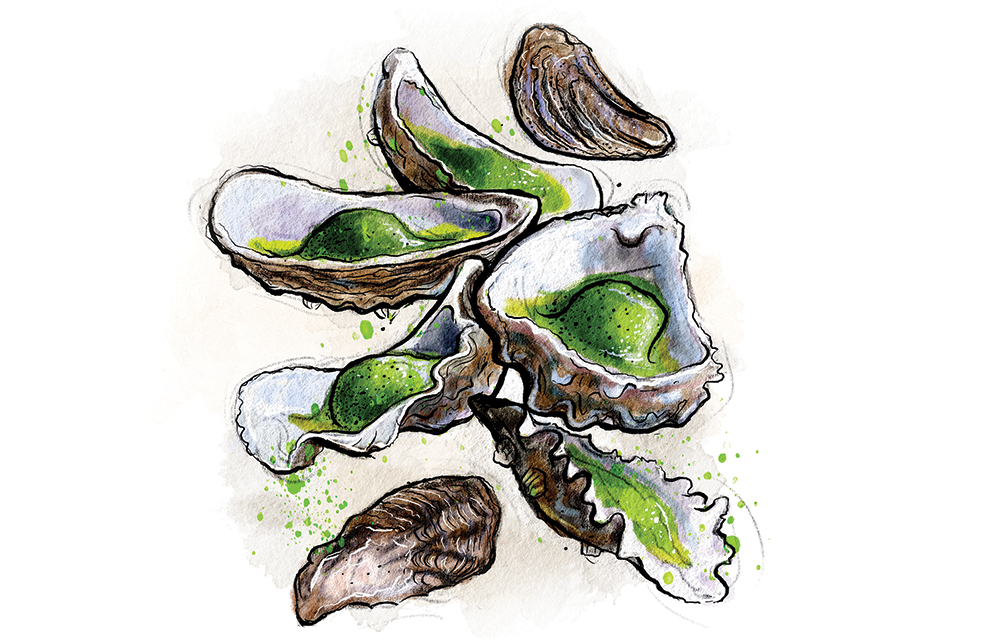There’s nothing more intriguing than a closely guarded secret recipe. Coca-Cola and KFC are two famous examples, with the precise ingredients for the soda syrup and special coating kept in guarded vaults: the story is that those who hold the information aren’t allowed to travel on the same plane in case of disaster. Lea & Perrins, Angostura Bitters and Chartreuse all keep their products’ make-up secret.
Making sure the butter is the brightest of greens is as important as any of the individual components
Nobody knows the recipe for oysters Rockefeller – or at least nobody knows the original recipe. It was created in 1889 at Antoine’s restaurant in New Orleans, which still stands today, serving the same classically French food it did back in the 19th century. It came about because the chef – Jules Alciatore, son of the eponymous Antoine – discovered there was a shortage of snails for an hors d’oeuvre, and used oysters in their place. The dish is therefore not dissimilar to the traditional preparation of escargots, with a green butter topping and the oyster cooked inside the shell under a hot grill.
Oysters Rockefeller have been served ever since, reportedly to the exact same recipe as when the dish was invented. But the recipe itself is a secret. Many attempts have been made to work out the components for the verdant topping, but the restaurant remains tight-lipped.
Here’s what we do know: the name is a nod to the richness of the dish, named after the Midas-like John D. Rockefeller. The oysters themselves are served on the half shell, spread with a mixture of garlicky, cheesy, anise-y breadcrumbs, chopped herbs and butter, then grilled until blistered and bubbling and swimming in green butter.
Antoine’s chefs have always denied that spinach is one of the ingredients in the dish. I am not one to disbelieve them. Intellectually, I accept that there is no spinach in the ‘correct’ version. But I also know that we eat with our eyes as much as anything, and making sure the butter is the brightest
of greens is as important as any of the individual components, and nothing bestows that as effectively as spinach. Its earthiness sits well alongside the fresh, almost medicinal quality of the parsley and tarragon, and smooths out the punch of garlic. So I am throwing caution to the wind and giving you my inauthentic interpretation.
Having eaten oysters Rockefeller at Antoine’s on honeymoon, I think you’d be hard-pressed to tell the difference, though perhaps that’s thanks to the Sazeracs we drank with them. Anyway, if anyone questions you about your components, just say your recipe is a proprietary secret.
On to the meat of the matter: how to shuck an oyster. Oyster shucking is a great party trick, and those who are practised make it look easy, but it also carries risks, especially for the novice. Ideally, wear a slash–resistant glove on the oyster-gripping hand (I am risk-averse and clumsy, so am an evangelist for these gloves, which I wear whenever I’m using a mandoline or boning out meat as well as for shucking), or as a bare minimum hold the oyster in a thick tea towel, which will protect you if your tool slips.
But the process of opening the oyster is actually very straightforward, even if it takes you a few goes to become proficient. What you’re trying to do is wedge the point into the thick hinge at the narrowest end of the oyster, and wiggle that upwards until it gives, then release the oyster from the muscle holding it to the shell. If you don’t have an oyster knife, the best way to shuck is to use a screwdriver to prise the hinge and lift the top shell, then use a knife to cut the muscle.
Once you’ve opened your oysters, the rest is a cinch: all the other ingredients are blitzed together to make that distinctive topping, which you spread on to each oyster before whacking them under the grill for a few minutes. The result is tender oysters bathed in herbal butter – so old school and completely delicious. Serve with crusty bread, for mopping up the juices and green buttery crumbs.
Serves 2–4
Takes 15 minutes
Cooks 10 minutes
- 30g parmesan, finely grated
- 30g fresh breadcrumbs
- 85g salted butter
- 1 tbsp tarragon leaves, chopped
- 1 tbsp parsley, chopped
- 50g baby spinach
- 1 clove garlic, peeled
- ½ tbsp Pernod (optional)
- 12 oysters, unshucked
- Using a food processor, whizz together all the ingredients except for the oysters to form a rich,
green butter. - Preheat the grill to medium high.
- Wrap a tea towel over your non-dominant hand, and hold an oyster firmly in it, flat side of the oyster facing upwards.
- Holding a screwdriver or a strong, blunt knife (or an oyster shucking knife) in your dominant hand, insert the tip of the blade into the hinge of the oyster (at its narrow end). Once you’re inside, twist to prise the hinge, and lift the oyster shell upwards. Slide your knife along the flat of the shell, to release the rest of the oyster. Leave the oyster in its shell, and repeat with the rest of them.
- Spread a generous tablespoon of the herby butter over the top of each oyster.
- Grill for five to ten minutes (keeping an eye on them to prevent burning), until the mixture is golden brown and bubbling.







Comments